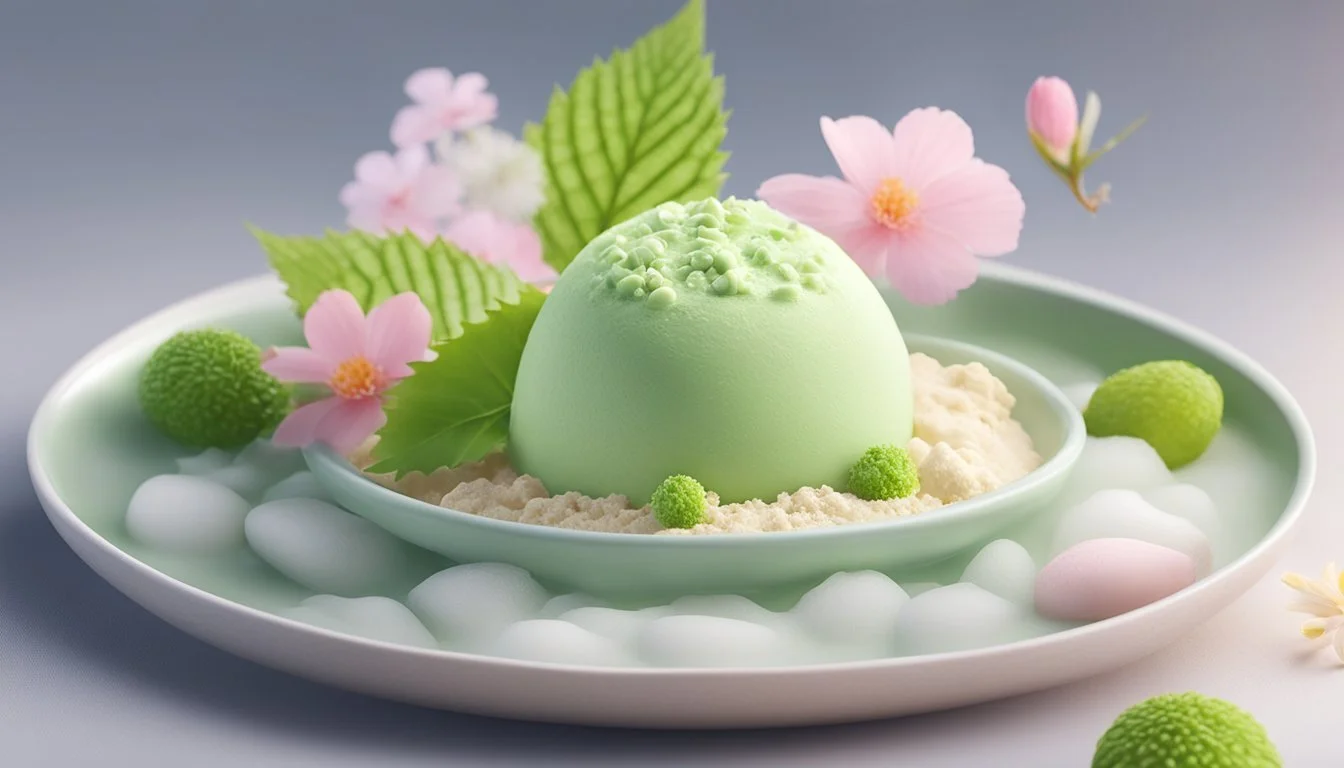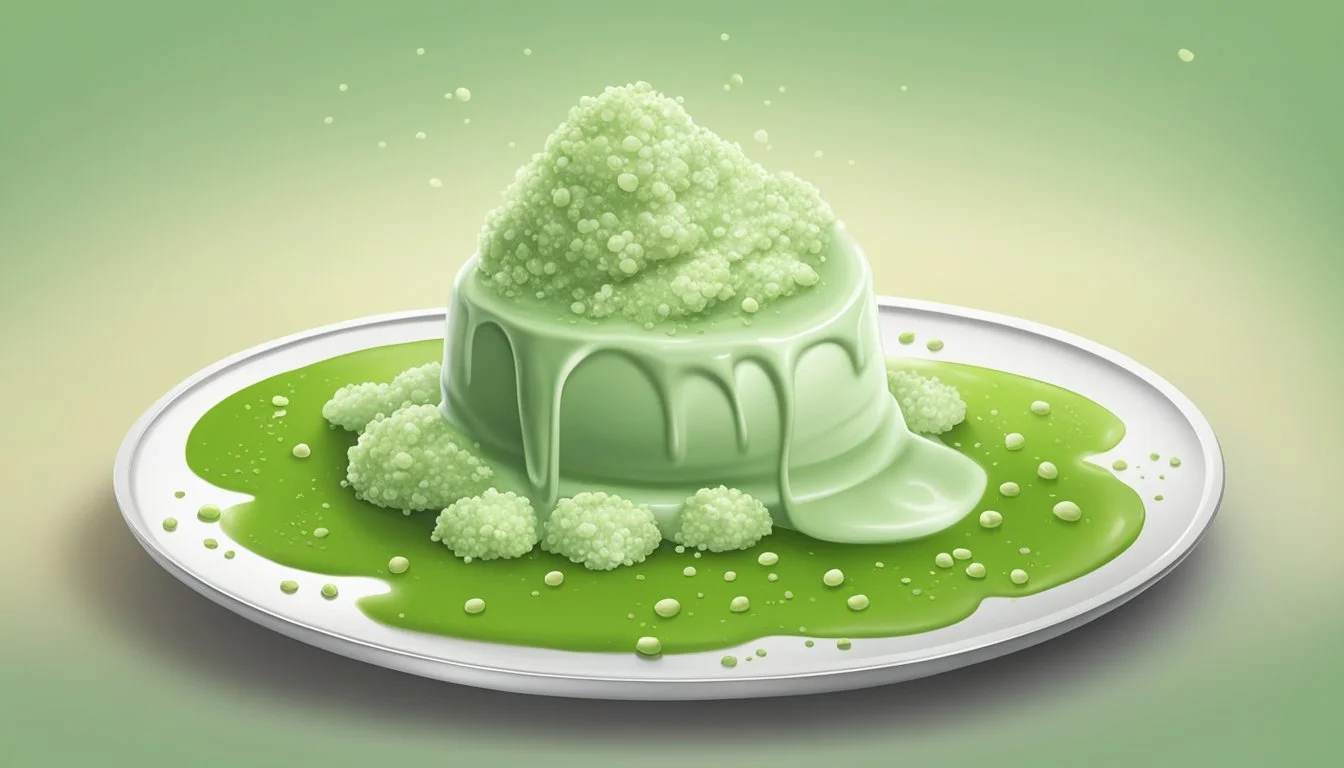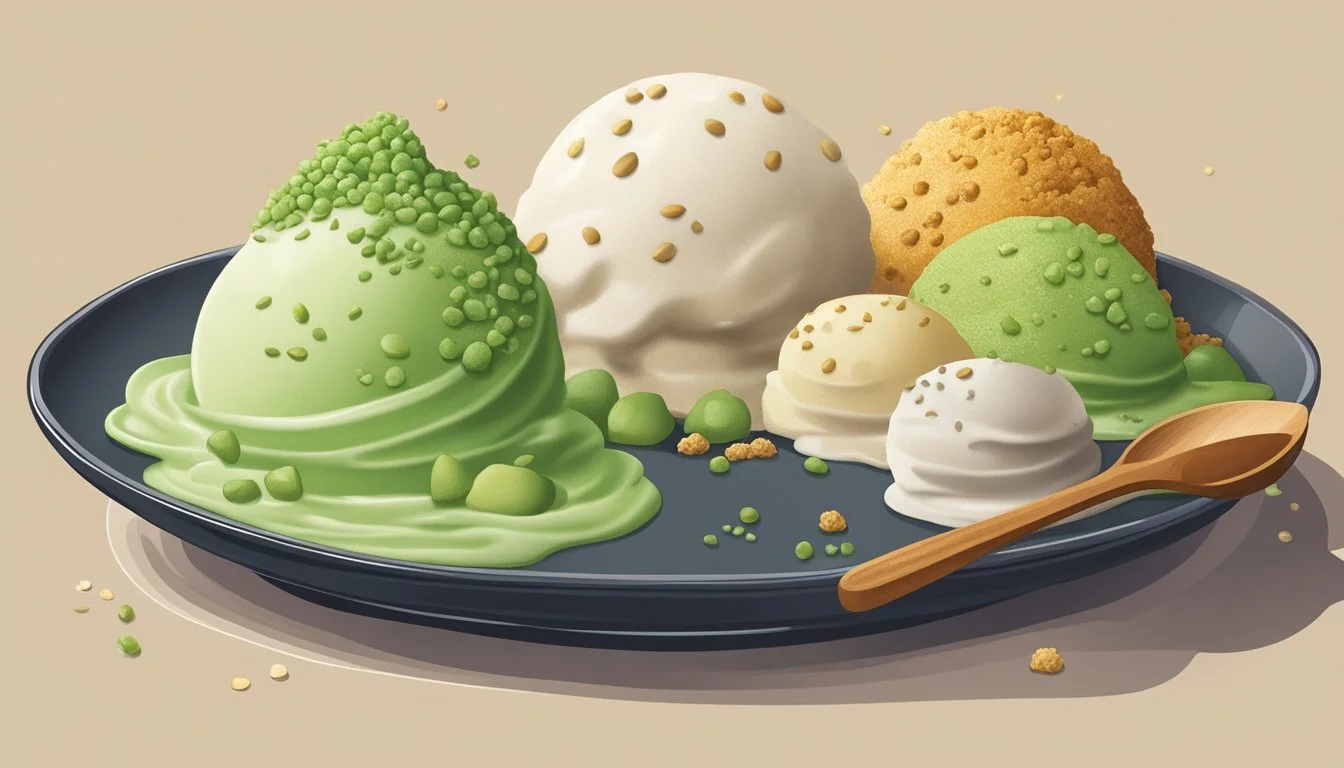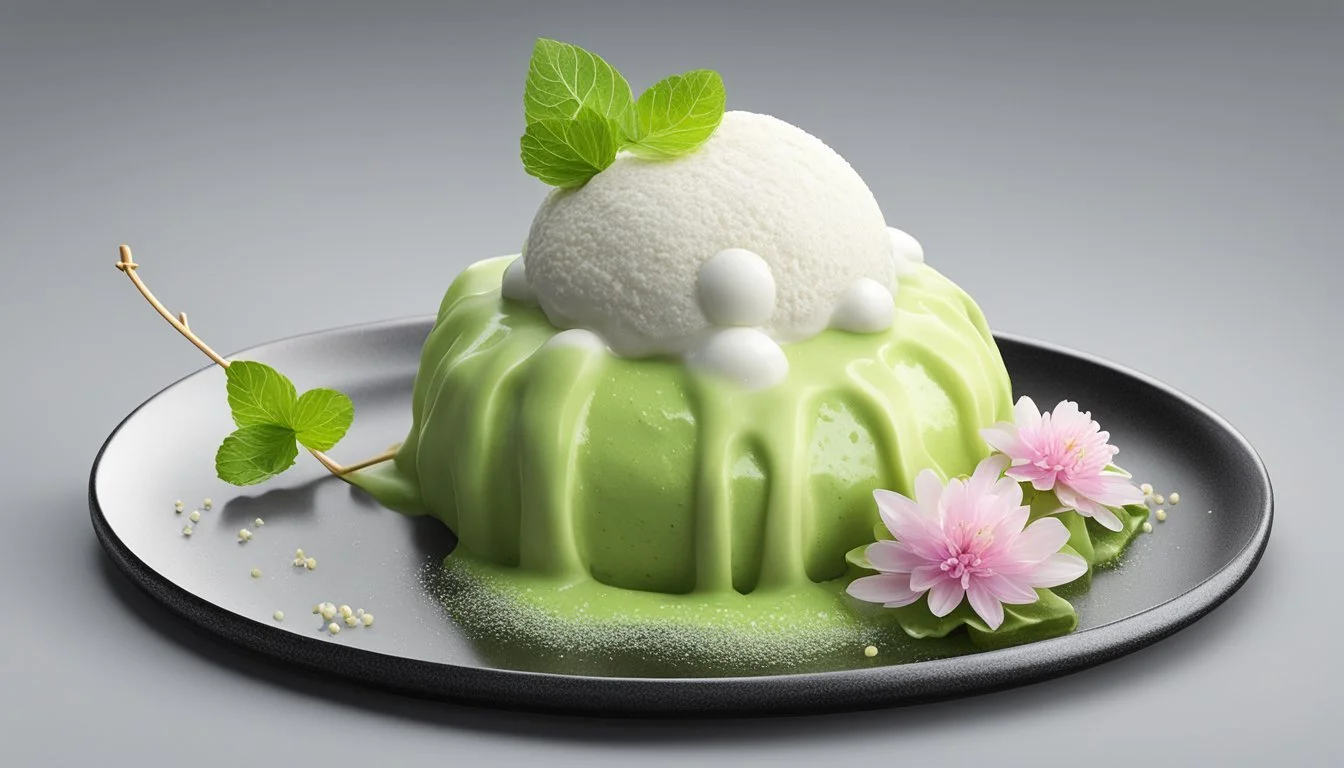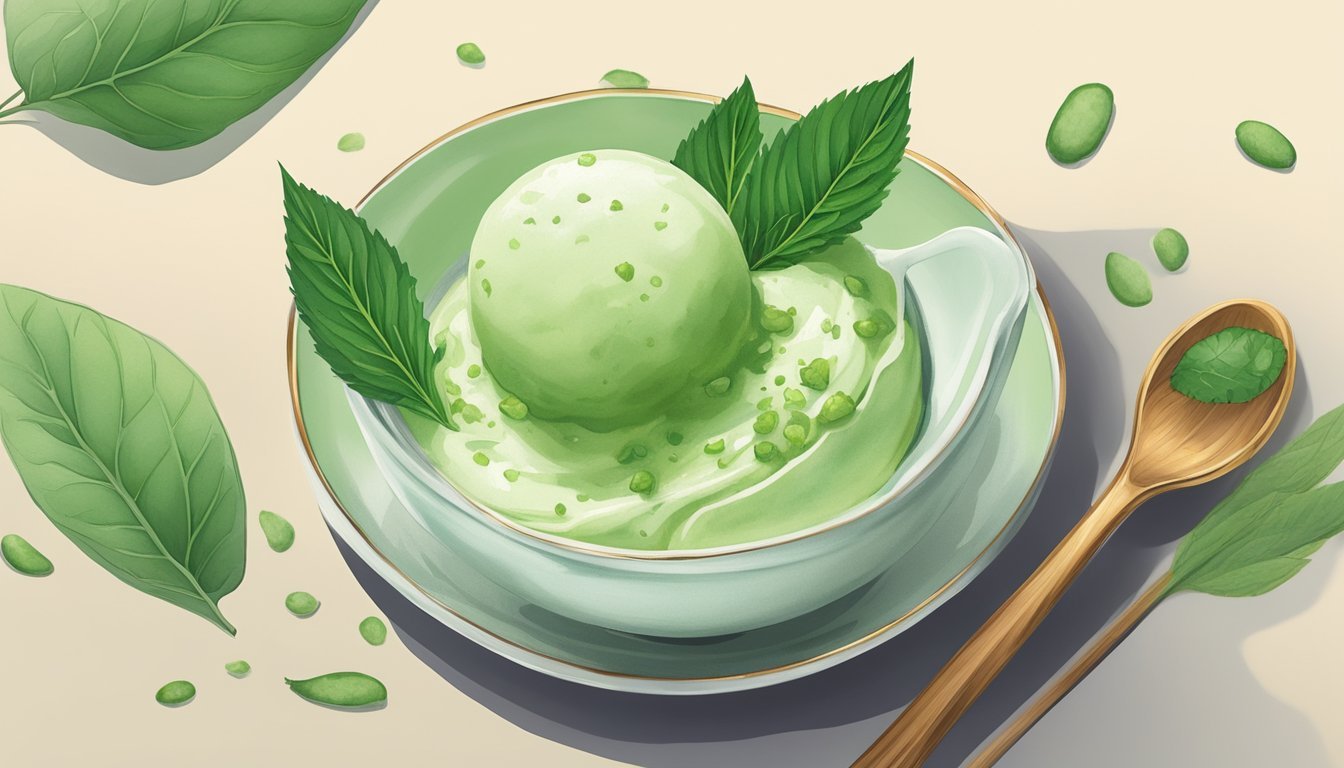Wasabi Ice Cream
A Bold Fusion of Chilly Sweetness and Sharp Spice
Wasabi ice cream emerges as a bold dessert choice, seamlessly combining the creamy sweetness of traditional ice cream with the zesty punch of wasabi. This innovative fusion dessert has piqued the curiosity of adventurous food enthusiasts and brought a refreshing twist to the conventional ice cream palate. The distinct flavor profile of wasabi, commonly recognized for its role in Japanese sushi (What wine goes well with sushi?) cuisine, imparts a surprising but pleasant heat that contrasts the coolness of the ice cream.
The taste of wasabi ice cream is reminiscent of mint ice cream at first, featuring a subtle initial coolness that gradually gives way to the sharply invigorating kick for which wasabi is renowned. This daring dessert tends to leave a nuanced spicy aftertaste that lingers, a testament to its authentic wasabi infusion. The intensity of the flavors may vary, allowing those new to the experience to ease into the unique combination, while wasabi lovers can indulge in a more robust concoction.
In crafting wasabi ice cream, culinary precision is key, ensuring a balanced mix where neither sweetness nor spiciness overpowers the other. This flavorful equilibrium makes wasabi ice cream not just a novelty treat but a sophisticated dessert option that stands out in the vast arena of ice cream flavors. The aim is to deliver an exciting eating experience, where the cool creaminess familiar to ice cream fans meets the distinctive, spirited essence of wasabi.
Exploring Wasabi as a Flavor
Wasabi ice cream is a Japanese dessert that perfectly marries the fiery zest of wasabi with the creamy sweetness of ice cream, creating a unique and memorable taste experience.
Origin and Cultural Significance
Wasabi, often associated with sushi, is a fundamental element in Japanese cuisine. Originating from Japan, its use in meals is well-regarded for both flavor enhancement and its historic believed health benefits. The cultivation of wasabi is intricate, with the Daio Wasabi Farm in Nagano Prefecture being one of the most renowned sites for traditional wasabi agriculture. This farm exemplifies the importance of wasabi, not only in terms of culinary applications but also as a cultural icon.
Japanese desserts (What wine goes well with desserts?) are often subtle in sweetness, and the integration of wasabi into ice cream is a testament to the culture’s innovative spirit in gastronomy. The flavor of wasabi ice cream is reflective of a culinary heritage that embraces contrasting tastes while maintaining a delicate balance in desserts.
Wasabi's Unique Taste Profile
Wasabi's flavor profile is complex. It is not spicy like chili peppers that induce a prolonged burning sensation; instead, it imparts a sharp, quick heat that dissipates rapidly. This is due to the natural compounds found in wasabi similar to those in horseradish and mustard. Its pungency is most intense when freshly grated, a common practice in authentic Japanese dining settings.
When introduced into ice cream, the initial zesty kick of wasabi is mellowed by the creamy dairy base, resulting in a dessert that is at once refreshing and surprising. The balance struck between the cool sweetness of the ice cream and the distinct kick of wasabi creates a flavor that is intriguing yet harmonious, captivating those adventurous enough to sample this unconventional treat.
Wasabi Ice Cream Fundamentals
Wasabi ice cream pairs the creamy, rich base of traditional ice creams with the zing of wasabi, providing a simultaneous experience of sweetness and heat. As a frozen dessert, it is paramount to balance the dairy components with the distinct wasabi flavor for a unique sweet treat.
Ingredient Breakdown
Key Ingredients:
Wasabi Paste: The central flavoring of this ice cream, imparting a hot yet sweet note.
Sugar: Balances the heat of wasabi with sweetness.
Heavy Cream: Adds richness and creates smooth texture.
Whole Milk: Contributes to the creaminess and helps in achieving the desired consistency.
Optional Ingredients:
Food Coloring: Green food color can be used to mimic the natural hue of wasabi.
Flavor Enhancers: Vanilla extract could be added for an aromatic sweetness.
Here is a simple list of the core ingredients for homemade wasabi ice cream:
1-2 tablespoons wasabi paste (adjust to taste)
1 cup sugar (can be adjusted for sweetness level)
2 cups heavy cream
1 cup whole milk
Green food coloring (optional)
Vanilla extract (optional)
Ice Cream Base Preparation
The ice cream base is essential for achieving the right balance between flavor and texture. One starts by whisking sugar, whole milk, and heavy cream together over moderate heat until well-combined and the sugar has dissolved. Then, the wasabi paste is incorporated evenly into the mixture. Care must be taken to avoid overbeating the mixture to prevent it from becoming too stiff.
Steps for Preparing the Ice Cream Base:
Combine sugar, whole milk, and heavy cream in a saucepan.
Heat gently, stirring until sugar is fully dissolved.
Stir in wasabi paste until fully integrated.
For added color, mix in the optional green food coloring.
Once the base is thoroughly mixed, it can be transferred into an ice cream maker to churn and freeze according to the manufacturer's instructions. For those making homemade wasabi ice cream without an ice cream maker, the mixture should be placed in a shallow container and put in the freezer, stirring every 30 minutes to ensure even freezing and to prevent ice crystals from forming.
Pairing Flavors with Wasabi Ice Cream
When it comes to wasabi ice cream, selecting the right accompaniments can enhance the unique taste of this Japanese dessert. Both complementary and contrasting flavors can create harmonious combinations that strike a balance between the ice cream's cool creaminess and its characteristic piquant heat.
Complementary Flavors
Complementary flavors are those that share similar taste profiles or characteristics with wasabi ice cream. They can amplify the ice cream's inherent flavors without overpowering it. Flavors like green tea and honey work well as they both offer subtle sweetness that can support the wasabi's zing without diminishing its presence.
Green Tea: Offers an earthy undertone that matches the intensity of wasabi.
Honey: Adds a natural sweetness that can soften the sharpness of wasabi while pairing nicely with its earthiness.
Creating Flavor Combinations
To create a captivating flavor combination with wasabi ice cream, one can turn to both sweet and savory elements that either soften, enhance, or contrast the wasabi's spicy kick.
For Sweetness:
Vanilla: The creamy and mellow flavor of vanilla can round out the sharpness of wasabi.
Chocolate: Particularly a hot fudge sauce, provides a rich contrast and adds a layer of indulgent sweetness.
For Contrast:
Strawberry: Its sweet and slightly acidic profile offers a refreshing counterpoint to the wasabi's heat.
Caramel Sauce: Brings a buttery sweetness that complements while contrasting the wasabi flavor.
By carefully selecting flavors that either meld with or stand up to wasabi ice cream, one can create delightful flavor combinations that make this intriguing dessert even more enjoyable.
Serving and Presentation
Wasabi Ice Cream can be an intriguing dessert selection that combines the creaminess of ice cream with the sharp, pungent kick of wasabi. When presenting this unusual dessert, careful consideration of accompaniments and visual elements enhances not only the flavor experience but also the aesthetic appeal.
Accompaniments and Toppings
A thoughtfully chosen accompaniment can balance the heat of wasabi ice cream and add textual interest. Here are some options:
Hot Fudge Sauce: A drizzle adds sweetness to counterbalance wasabi's intensity.
Coconut Milk Whipped Cream: A dollop of whipped cream made with coconut milk complements the spice and adds a tropical twist.
Lime Juice: A few drops brighten the flavor profile and can cut through the richness.
Pickled Ginger: Small pieces serve as a palate cleanser and bridge the gap between wasabi's spiciness and the dessert's sweetness.
Mint: Fresh mint leaves can offer a cool and refreshing contrast and pairs well with wasabi.
Visual Appeal
The presentation of wasabi ice cream is crucial in heightening diners' anticipation. Employing these visual elements can enhance the dish's appeal:
Color: A hint of green food coloring can intensify the ice cream's natural pale green shade, hinting at the flavor within.
Garnishes: Fine slices of pickled ginger, minimal sprigs of mint, or a light dusting of wasabi powder can be both decorative and suggestive of the flavors, striking the right balance between intrigue and elegance.
Innovative Culinary Uses
Wasabi ice cream is not just an audacious choice for the adventurous eater; it represents a creative intersection of heat and sweet, challenging traditional dessert boundaries.
Fusion with Other Japanese Dishes
Sushi: Traditional sushi often pairs with wasabi paste to enhance its flavors. In a twist, the sushi experience is reimagined by serving wasabi ice cream alongside sushi rolls. This novelty provides a contrasting creamy texture with a subtle heat that complements the fresh, delicate flavors of sashimi or nigiri.
Ramen: A dollop of wasabi ice cream can be placed on top of cold ramen dishes during summer months, offering a refreshing and unexpected flavor profile that marries well with the savory broth and noodles.
Revolutionizing Dessert Menus
In Japan, wasabi ice cream is transforming dessert menus, bringing a new level of excitement to the last course.
Dessert Innovations:
Toppings: A scoop of wasabi ice cream can elevate traditional Japanese desserts like mochi or dorayaki with its surprising kick.
Matcha Pairings: The ice cream pairs exquisitely with matcha green tea, providing a harmony of heat and bitter-sweetness that is both sophisticated and memorable.
By incorporating traditions with a modern twist, wasabi ice cream is setting trends in the culinary world and expanding the horizons of Japanese dessert offerings.
Nutritional Profile and Dietary Considerations
Wasabi ice cream is an intriguing dessert where the punch of wasabi is embraced by the creaminess of traditional ice cream. This section examines the nutritional aspects of wasabi alongside the available dietary variations of the dessert.
Health Benefits of Wasabi
Wasabi, a potent herb akin to horseradish, is renowned for its health benefits. A tablespoon of wasabi contains about 47 calories, 7.4 grams of carbohydrates, and 1.7 grams of fat. It packs a high concentration of antioxidants, which play a role in reducing the risk of chronic diseases and fighting inflammation. Additionally, studies have suggested compounds in wasabi may possess anti-cancer properties.
Nutritional Highlights of Wasabi (per tablespoon):
Calories: 47
Carbohydrates: 7.4g
Fats: 1.7g
Antioxidants: High
Cancer-Fighting Compounds: Present
Alternative Dietary Options
When considering dairy and gluten dietary restrictions, wasabi ice cream can be crafted to fit these needs. Dairy-free alternatives, such as coconut milk, offer a rich texture while adhering to vegan or lactose-intolerant dietary preferences. These options ensure the ice cream retains its sweet essence and compatibility with the bold flavor of wasabi.
For gluten-free diets, one must ensure that all components, such as any added soy sauce, are devoid of gluten. Most wasabi ice creams can be tailored to be gluten-free, provided that careful attention is paid to the ingredients used.
Dietary Variations Available:
Dairy-Free: Coconut milk, almond milk
Vegan: Substitute with plant-based dairy alternatives
Gluten-Free: Verify ingredients like soy sauce for gluten
This dessert presents a nutritious indulgence for those seeking a unique fusion of flavors, catering to varied dietary needs without compromising on the vibrant wasabi experience.
Conclusion and Final Thoughts
Wasabi ice cream is an innovative dessert that merges the zesty kick of traditional Japanese wasabi with the creamy indulgence of ice cream. It exemplifies the adventurous spirit found in culinary experimentation, particularly within the realm of Japanese desserts.
Flavor Profile: The flavor of wasabi ice cream can surprise those unaccustomed to spicy treats. Its initial coolness may resemble that of mint, only to be followed by the characteristic heat of wasabi. The ice cream does not just offer heat; there is an underlying sweetness and complexity that can be quite pleasant.
Culinary Pairings: Despite its uniqueness, wasabi ice cream can be paired with various components. A slice of cucumber could provide a refreshing balance, playing into the heat with its coolness.
Wasabi ice cream may not be a dessert for everyone, but it certainly makes a statement. It is a bold choice—but one that speaks to the creativity found in Japanese desserts and the expanding global palate. What it offers is more than a novel taste; it provides an experience, a blend of coolness with a swift kick of heat, leaving an unforgettable impression on those who dare to try it.

